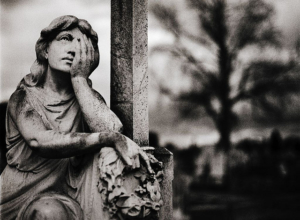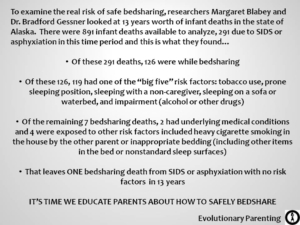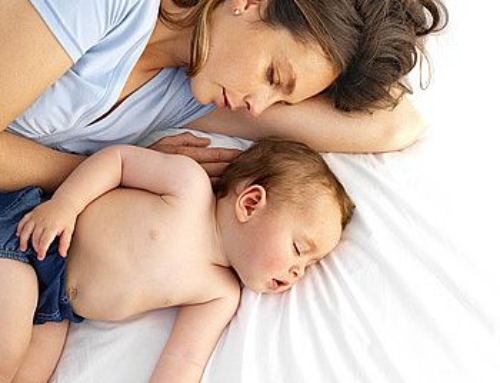So the following video is making the rounds on the interweb as a means of discouraging parents from bedsharing. Take a moment and watch it yourself (I recommend staying away from hard things you might bang your head on, causing injury):
Hello Ms. Cop. Might I first ask what your qualifications are to talk about infant sleep and safety? Are you a researcher on the side? Do you know the circumstances of the babies that have died? Did you do the autopsies? No, I imagine you are used here to instill a sense of fear and authority. After all, a cop tells you not to do something, you’d better think twice before doing it because the implication is it’s illegal and you can go to jail. Great start.
Onto the first comment – that over half of babies die in unsafe sleep environments. I would love the actual stat, but I’m not arguing against this because I’m sure it’s true in the sense of what we conceptualize as an “unsafe” sleeping environment. The problem is that if it’s close to 50%, we also need to know how this compares to the percentage of people who have babies in these same sleeping environments. The reason this matters is that we need this to understand the actual risk – if 50% of families have babies in unsafe sleep environments (and according to a recent finding, 55% are in this category for bedding alone, like soft blankets and comforters) and 50% of babies are dying in these environments, is the environment that unsafe or are we looking at red herrings?
I know there have been studies on many of these factors (like bumpers and pillows and comforters in cribs) and they do show an increase (though the relative increase is one that families may accept or not, depending on the benefit that’s associated with it, but we’ll get to that later), but the problem is that the actual risks aren’t being given here to allow families to understand the individual risks they may or may not be taking. Instead, we’re clearly getting a fear-mongering campaign.
So we have the ABC of safe sleep, but unfortunately there’s a little problem with A. You see, I want to say I “know” it means babies should be sleeping by themselves, on their own sleep surface, not next to anyone else; HOWEVER, it also reads that they should be alone. As in, in another room alone. Which is ridiculous and increases the risk of SIDS. As much as I want to give them credit that they mean the former, I just can’t give them that credit because they haven’t earned it.
Now comes the focus on bedsharing. Although this started as a generalized “safe sleep” video, the main intention becomes clear: Bedsharing is, as put in the video, “very dangerous”. Did you know babies have died while bedsharing?!?! (They clearly omit how many and how many have died in cribs.) Ms. Cop manages to discuss all the problems that can exist in family bed situations are mentioned without a single discussion of how to make it safer. Instead, the focus is on fear and what a dangerous, horrible thing bedsharing is (even though it’s not).
If the voice over wasn’t enough to scare you, the video of a woman sleeping certainly should. Here we see a woman who is sleeping without the baby in her bed, moving around all over the bed. First, the sleep of people alone versus with children is different. In fact, sleep is so varied that we have identified differences in bedsharing sleep between breastfeeding and formula feeding mother-infant dyads. To suggest that sleep is the same for parents who bedshare, those who do not bedshare, and non-parents is just plain ignorant. However, has anyone else noticed the time stamp on this video is just crazy? Goes up then down then up – frankly it seems like it was cut together to make the most frantic, roll-around, crazy sleep ever. If it’s truly from one night then they have flat-out lied to make it look as bad as it does based on the times given.
Second, the situation in the video is quite possibly not a safe place to put a baby – especially not in the middle of the damn bed like they do in this video, with knees into the baby’s stomach and blankets crumpled up everywhere. However, the video does suggest something most people ignore (and doesn’t make sense with the timeline in the video, but alas, that’s what we’ve got) – the mother is sleeping and has to get up to get baby, she doesn’t rearrange the bed at all and is presumably doing it in the middle of the night when she’s tired, meaning the bed isn’t prepared to bedshare safely. The situations in which women find themselves bedsharing unintentionally are also ones that can lead to even more dangerous situations. In fact, one of the biggest problems with campaigns like this is that they may actually be putting more babies at risk as parents engage in riskier practices in order to avoid bedsharing.
Now the video moves onto the crib safety tips… oh wait, there aren’t any. Which is awesome because, really, why do parents need to know about the many unsafe sleep environments that can happen when sleeping in a crib? Where’s the discussion of toys, pillows, blankets, bumpers, etc. that claim the lives of infants sleeping in cribs each year? When that discussion and associated visual is absent, it makes bedsharing seem like the only contributing problem when in fact it’s not. Researchers in Alaska examined each infant death from SIDS or suffocation where bedsharing was involved and guess what they found? Only 1 death over the span of 13 years was found to have NO risk factors for bedsharing. ONE.
Where should the focus be? Teaching families how to safely bedshare because despite all these anti-bedsharing campaigns, bedsharing continues to rise. Why? It works. It helps breastfeeding, gives moms more sleep, and is a great way to facilitate touch with infants who direly want that closeness. It may not be for every family, but we have evolved as humans to keep our babies close – they expect it and we expect it. Violating that norm is something we should think long and hard about advocating against, especially when there are clear guidelines about how to bedshare safely.
I want to address the issue of risks and benefits here too. The focus on bedsharing in the safe infant sleep environments discussion is remarkable because it’s the one area in which there is a consistent benefit to contend with. What I mean is that when you speak of pillows or bumpers or extra blankets and toys in cribs, there’s very little or no benefit to their presence (there may be certain exceptions here, but speaking by and large) yet they get far less attention than bedsharing. With bedsharing the benefits are tangible: Breastfeeding increases, mothers get more sleep, and infants receive precious and much-needed touch that is lacking in Western cultures. With these benefits, it’s no wonder that bedsharing has been said to not “be a modifiable infant-care practice that can be influenced by risk-education and simple recommendations” (Ball & Volpe, 2013).
If you want to help families, you have to realize that you’re asking people to change something that isn’t going to change for many, many reasons that are all valid. Instead, focus on teaching people how to bedshare safely and make sure their bed is safe at all times in case they end up tired and wanting to breastfeed in bed. There really should be no other plan at this point.








291 dead of SIDS (and/or suffocation) 126 of them during unsafe bedsharing…doesn’t take a math brain to notice that means 165 died in cribs. Which is why SIDS has been called ‘Crib Death’ since it was first described. Babies may die of suffocation in unsafe sleep situations, which may include with another person, but they die of SIDS almost exclusively when they are a in a crib by themselves. It’s Crib Death. There is lots you can do to avoid suffocation in a sleeping situation, trading in ‘suffocation’ risks for ‘Crib Death’ isn’t one of them.
My reaction exactly. Well put! Thank you!
It doesn’t help that the CPSC is in bed with a huge association of crib manufacturers–they sponsor the latest and largest campaign against cosleeping. What’s sad is how our health and medical communities so blindly parrot this crap. It’s like none of these people have any real world experience.
My husband and I have always joked that our ancestors certainly didn’t put baby on the other side of the cave when they slept.
That video is very obviously biased and ill informed; it is definitely propaganda and missing the opportunity to share useful information about planned bedsharing.
When I wake up next to my baby, my sleeping position has not changed at all. Even my husband wakes up to change position. We are aware of our baby even when we are asleep.
This is utterly BS – irresponsible and totally lacking facts! OMG!
Co-sleeping is a common practice worldwide: The rate of SIDS is lowest in cultures that traditionally share sleep, such as Asian. While there could be many other factors contributing to the lower incidence of SIDS in these cultures, all the population studies I’ve seen have come to the same conclusion: Safe co-sleeping lowers the SIDS risk.
My own daughter is a Police officer and I would be scolding her for doing such an off the cuff information video such as this! Who in the hell’s bright idea in the public service department directed this YOUNG officer to do such a scripted public service video?
Having had 5 children myself ( yes I am a 55 yr old grand mother of 6) and co-slept and nursed my first 4, her (the police officer) being my 3rd, and my youngest was born 3 months early, and when we brought her home from the hospital 77 days later,(in -34 degree weather) at 6lbs, it was in our bed that she slept. Totally Stupid public service educational video! Dumb!
Quit putting so much fear into our New parents and New Mothers!
Good Lord! I know of babies “in the Olden Days” that their first “Bed” was a shoe box, and then up to a dresser drawer! Egads – tired of these fear mongers for new moms and dads!!
Good article from Dr Sears – (of whom I have met personally)
http://www.parenting.com/article/ask-dr-sears-co-sleeping-a-sids-danger
Dr. Sears: Co-Sleeping a SIDS Danger?
Co-sleeping helps your baby rouse himself: New research has shown that in most cases, SIDS is caused by a baby’s inability to arouse himself from sleep. Normally, when something occurs that threatens your baby’s well being, such as difficulty breathing, he will automatically wake up. For reasons that are still unknown, in some babies, this protective mechanism does not go off, and so these babies are more at risk for SIDS.
This is where the positive aspects of co-sleeping come in. Dr. James McKenna, director of the Mother-Baby Sleep Laboratory and Professor of Anthropology at the University of Notre Dame, has conducted numerous studies of mothers and babies who were co-sleeping and night nursing. His group of researchers found that mom and baby share similar patterns of sleep arousals, what we call “nighttime harmony.” They drifted in and out of sleep stages in a similar, but not always identical, pattern. Some SIDS researchers believe that this is a factor in baby’s protective arousal mechanism. This harmony may also be related to a psychological synchronicity between co-sleeping mothers and their babies: The co-sleeping mom is more likely to subconsciously sense if her baby’s health is in danger and wake up.
Researchers also believe that the carbon dioxide you exhale when you sleep close to your baby may help stimulate her breathing. Plus, co-sleeping infants tend to automatically sleep on their back, in order to have easier access to nighttime feedings. Back sleeping has proved to be one of the top risk-reducers for SIDS. Meanwhile, babies who sleep separately from their moms have been shown to experience a decrease in the amount of REM sleep, the state of sleep in which protective arousal is the most likely to occur.
Co-sleeping is a common practice worldwide: The rate of SIDS is lowest in cultures that traditionally share sleep, such as Asian. While there could be many other factors contributing to the lower incidence of SIDS in these cultures, all the population studies I’ve seen have come to the same conclusion: Safe co-sleeping lowers the SIDS risk.
Co-sleeping warnings are based on imprecise science: I began my pediatric career in academic medicine and teaching in university hospitals. At that time, I learned an important lesson about scientific research: When the conclusions of a scientific study and common sense don’t match, suspect faulty science. Both Dr. McKenna’s writings and my two books mentioned above contain information that proves the original studies that triggered the “alarm” about co-sleeping were flawed.
In addition, scientists have yet to come to a universal agreement on the definition of co-sleeping. I’ve always considered co-sleeping to mean bed-sharing or sleeping within arm’s reach of mother; however, it can also be defined as simply being close to mom or sleeping in the parents’ bedroom. No matter your interpretation, you will find general agreement among all SIDS researchers, pediatricians, and the American Academy of Pediatrics that sleeping in the same room with parents lowers the risk of SIDS.
Co-sleeping is as safe as the conditions you practice: For obvious reasons, parents under the influence of alcohol, drugs, or medications that interfere with normal sleep patterns should never have their baby in their bed. Other safeguards to employ:
Sleep in a king-size bed if possible, to give everybody enough room.
Be sure there are no wide crevices between the mattress and the guardrail or headboard that your baby’s head could sink into.
Never allow infants to sleep in the same bed with siblings or caregivers – they may not have the same awareness of a baby’s presence that parents do.
Don’t fall asleep with your baby on a surface that isn’t firm, such as a couch or a beanbag chair; she could suffocate by getting wedged between the cushions.
Many parents have resolved co-sleeping worries by using a bedside co-sleeper: a crib-like bed that attaches securely to the side of your mattress. This allows you to have your own sleeping space on your bed, while your baby sleeps within arm’s reach for easy nursing and comforting.
I hope you continue to enjoy co-sleeping with your baby, practice it safely, and reap the rewards of feeling more connected with each other. Just remember — wherever you and your baby get the best night’s sleep is the right arrangement for your family.
I can’t believe the Bothell City Council was OK with having their name on this video. If a parent follows this video and then the baby dies alone in the crib, they are at risk for being sued.
I’d be interested in the ferguis for babies being smothered when co-sleeping. Coroners also deal with lots of cases of babies who are smothered on sofas etc because their mothers fall asleep whilst feeding them and are trying to keep awake long enough to put them back in their own beds. I’ve known people whose babies have rolled off their knees when they’ve fallen asleep in a rocking chair whilst feeding. If it’s done safely it’s not dangerous, this is a myth. Other cultures do this all the time and don’t have higher incidents of cot death because it is the norm’ and done safely. There are studies that show that the baby adjusts it’s breathing to match the mothers breathing when co-sleeping. Also, breastfeeding helps protect against cot death and co-sleeping helps breastfeeding.I think everybody has a choice and has to do what feels right for them and their baby but these choices have to be based on facts and not scaremongering myths.